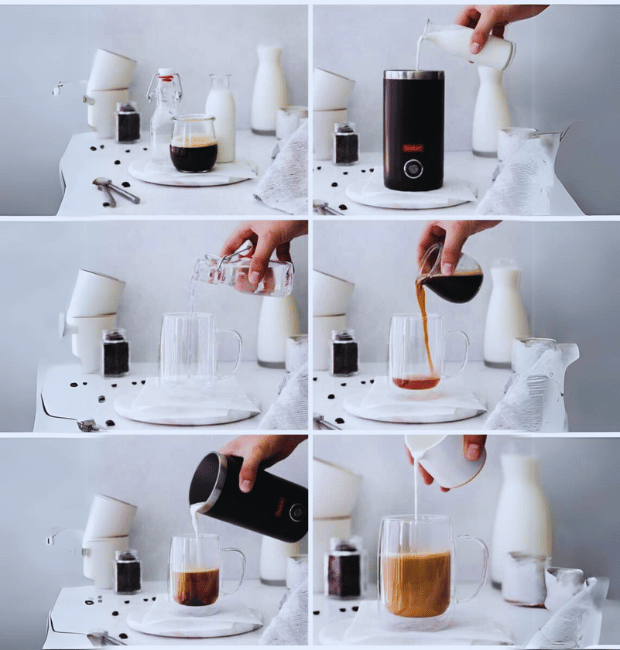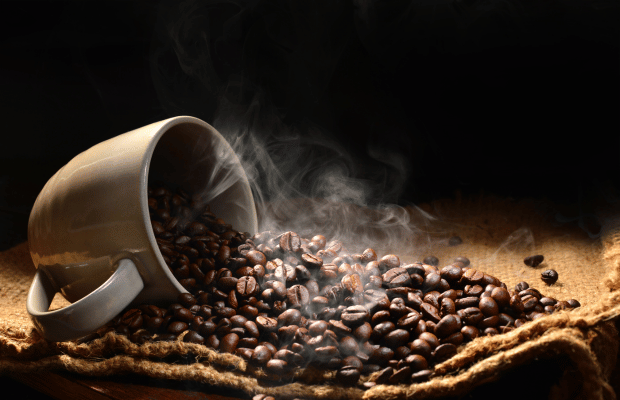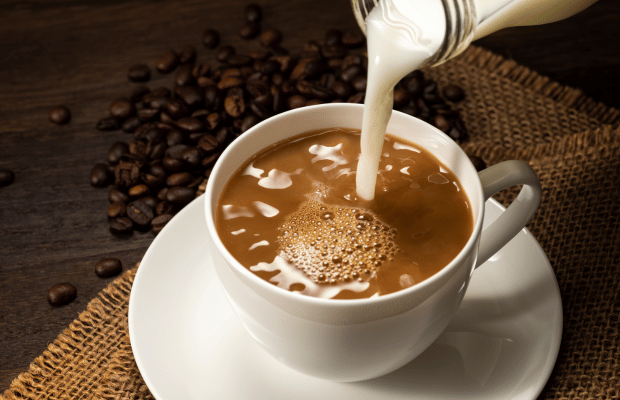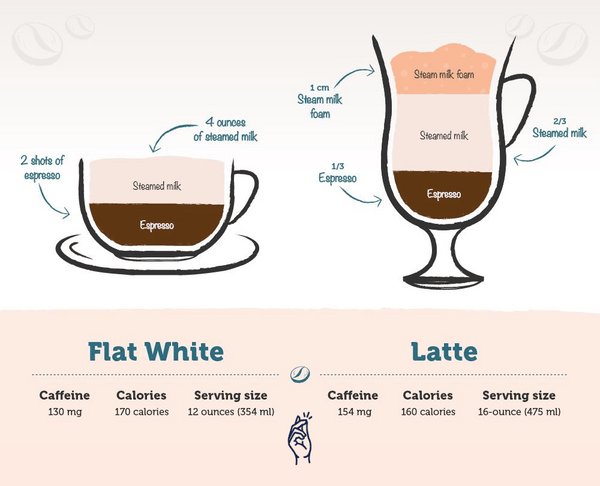Are you interested in learning about a popular coffee drink called Flat White Coffee? In the big world of coffee, the flat white stands out as a top choice for people who love a strong espresso mixed just right with smooth milk. We're going to take a closer look at what makes flat white coffee so special and answer the common question: What is a flat white? Get ready to enjoy and learn more about why this beverage is a favorite for coffee lovers everywhere.
What Is a Flat White Coffee?

You might have heard people at coffee shops talking about flat white, but what exactly is it? A flat white is more than just a regular coffee—it's a special mix of strong espresso and smooth steamed milk that really hits the spot. This drink started in the coffee-loving scenes of Australia and New Zealand and has become popular all over because of its creamy feel and deep coffee taste. So, what makes flat white coffee different from other coffee drinks?
Unlike a latte or cappuccino, a flat white has more instant coffee and less milk, giving you a richer espresso taste with a soft, creamy top. It's the perfect choice if you like your coffee with a bit of a kick but still want that smooth milkiness. And here's something people often get mixed up: flat white vs. white coffee or flat white vs latte. A flat white is all about that double shot of espresso with steamed milk on top. White coffee, on the other hand, is actually about the beans—it means coffee made from beans that are roasted really lightly. So, when you're craving something rich and creamy with a strong coffee flavour, go for a flat white.
The Perfect Composition of a Flat White

1. Start with Strong Espresso:
- Foundation: At the heart of every flat white coffee is a robust shot of espresso.
- Preparation: Use finely ground coffee beans for that intense flat white flavour.
- Brewing: Extract this key component under high pressure to capture the bold essence of what makes a flat white stand out.
2. Microfoam Milk - The Key Differentiator:
- Definition: The signature of a flat white beverage is its microfoam milk, which is smoother than the froth in other coffee drinks.
- Texture: Achieve a velvety consistency that's crucial for the flat white's luxurious feel.
- Technique: Master the steaming process to create the perfect microfoam that makes a flat white truly unique.
3. Achieving the Balance:
- Ratio: Balancing the bold espresso with the right amount of creamy microfoam is key to the flat white's harmony.
- Integration: Carefully combine the espresso and milk to highlight the rich, espresso flavour while maintaining the flat white's creamy texture.
- Result: This balance is what defines a flat white coffee, offering a rich yet smooth coffee experience that stands apart from other beverages like lattes or cappuccinos.
Remember, the essence of a great flat white lies in the quality of the espresso and the texture of the milk. Getting both elements right will result in a delicious, creamy, and satisfying coffee drink.
How to Make a Flat White Coffee: A Step-by-Step Guide

1. Gather Your Ingredients:
- Espresso: Start with a freshly brewed double shot of espresso. If you have a coffee pod machine, use flat white coffee pods for convenience.
- Milk: Choose high-quality whole milk for the creamiest texture.
- Optional: Add sweetener or flavoured syrup to taste.
2. Prepare Your Espresso:
- Using an espresso machine, pull a double shot of espresso directly into your cup. For a simpler option, flat white coffee pods work great.
3. Steam Your Milk:
- Fill a stainless steel jug halfway with cold milk. Using your espresso machine's steam wand, heat the milk just below the surface, creating a smooth microfoam with tiny, uniform bubbles. This step is crucial for achieving the silky texture characteristic of a flat white.
4. Pour and Texture:
- After steaming, tap the jug to remove large bubbles. Pour the milk into the espresso from a slight angle, allowing the milk to mix while keeping the microfoam on top. This creates the flat white's signature smooth, velvety layer.
5. Add Your Personal Touch:
- Customise your flat white by adding a sprinkle of cocoa or cinnamon, or a drizzle of caramel syrup for extra flavour.
- For an iced flat white, start with espresso over ice, then top with cold, frothed milk for a cool variation.
6. Sip and Enjoy:
- Congratulations! You've just made a flat white coffee at home. Enjoy the balanced blend of bold espresso and creamy milk in your perfect cup.
By following these steps, you'll be able to craft a delicious flat white at home, whether you prefer it hot or as an iced flat white. Curious about the caffeine kick in your Flat White? Learn more about caffeine levels in your favorite brews with our 'How Much Caffeine is in Coffee' guide.
Flat White vs White Coffee
This table compares the key features of Flat White and White Coffee, highlighting their origins, definitions, and characteristics.
| Feature | Flat White | White Coffee |
|---|---|---|
| Origin | Australia and New Zealand | Originates from the type of bean and roast, not a specific location |
| Definition | A coffee drink made with a double shot of espresso and topped with creamy microfoam milk | Refers to coffee beans that are lightly roasted at lower temperatures |
| Coffee Base | Espresso | Lightly roasted coffee beans |
| Milk Content | Characterized by the specific ratio of espresso to microfoam milk | Not defined by milk content; milk may not be involved |
| Texture & flavour | Rich and creamy due to the microfoam milk; strong espresso flavour | Nutty, earthy flavours with milder acidity due to the light roast |
| Appearance | Typically has a velvety texture on top with a dark coffee base | Pale or "white" appearance of the beans, leading to a lighter coffee color |
| Common Misconception | Often confused with other milk-based coffees like lattes or cappuccinos | Often mistaken for a milky or creamy coffee drink |
Exploring Flat White Variations
1. Personal Touches:
- Like customizing a sandwich, everyone has a unique way of preparing their favorite espresso-based drink.
- Variations can include adjustments to the drink's size or experimenting with different milk types.
2. Regional Flavours:
- In cities with a vibrant coffee culture, such as London, this espresso drink holds a special place, becoming a local favorite.
- Cafés might add regional flavours or local ingredients, offering a taste of the area's culinary character.
3. Size and Strength
- Traditional sizes vary, with some preferring a more concentrated cup, while others may opt for a larger, more leisurely serving.
- Adjusting the espresso to milk ratio can cater to personal preference for strength and texture.
4. Milk Varieties:
- Experimenting with alternative milk options like almond, soy, or oat milk to cater to dietary preferences and taste profiles.
- The choice of milk can significantly alter the texture and flavour, providing a new experience even for familiar drinkers.
5. Flavour Infusions:
- Introducing subtle flavours such as vanilla, caramel, or hazelnut to enhance the drink without overpowering the espresso.
- Seasonal variations might include spices like cinnamon or nutmeg for a festive twist.
6. Espresso-Only Option:
- For purists who appreciate the intensity of espresso, an espresso-only version offers a bold, undiluted coffee experience.
- This variation focuses on the quality and character of the beans, appealing to those who prefer a straightforward coffee flavour.
7. Global Inspiration:
- Drawing inspiration from coffee traditions around the world to introduce new and exciting variations.
- This could mean incorporating techniques or ingredients from different cultures, adding a global flair to the drink.
- By exploring these points, you'll gain a deeper appreciation for the creativity and diversity within the coffee community, discovering new ways to enjoy your favorite espresso drink.
The Science Behind the Perfect Flat White

Creating the perfect coffee drink involves a bit of science mixed with art. Here's how you can make a great version of this espresso-based drink:
|
Aspect |
Detail |
How to Do It |
|
Bean Quality |
Start with high-quality beans for depth in your flat white. |
Choose beans from reputable sources, focusing on origin and roast type. |
|
Grind Precision |
A fine grind is key for rich flat white coffee extraction. |
Use a burr grinder for consistent grind size, aiming for a fine texture. |
|
Espresso Shot |
The foundation of a flat white is a well-extracted espresso shot. |
Use an espresso machine to pull a double shot, looking for a rich crema. |
|
Milk Choice |
Whole milk adds creaminess to the flat white beverage. |
Opt for fresh, whole milk for its fat content and texture contribution. |
|
Microfoam |
Achieve velvety microfoam for a smooth flat white texture. |
Steam milk to 60-65°C, creating microfoam with tiny, consistent bubbles. |
|
Milk-Espresso Balance |
Balance milk and espresso for the perfect flat white coffee. |
Pour steamed milk over the espresso, maintaining a 1:3 or 1:4 milk to coffee ratio. |
|
Pouring Skill |
A steady pour blends the milk and espresso in a flat white. |
Tilt the cup and pour milk from a low height, gradually straightening as the cup fills. |
|
Serving Temperature |
Correct temperature ensures the best flavour of your flat white. |
Serve immediately after preparation to enjoy at optimal warmth. |
|
Personal Touch |
Adjust to taste when making a flat white at home. |
Experiment with different beans, milk types, or syrups to find your preferred flavour. |
Choosing the Right Beans for Your Flat White

- Understand Bean Origin: Whole Bean Coffee from different regions offer distinct flavour profiles. For a flat white, you might want beans with a balanced profile of acidity and sweetness. Presto Coffee offers a variety of beans from renowned coffee-growing regions that can suit the rich and smooth character of a flat white.
- Consider the Roast: The roast level of the coffee can greatly affect the taste of your brew. For a flat white, a medium to dark roast is ideal as it complements the creamy texture of the milk with its richer, more robust flavour. Presto Coffee's range includes options that are perfect for this.
- Freshness is Key: Always check the roast date. Freshly roasted beans, ideally used within a month from the roast date, will give you the best flavour. Presto Coffee prides itself on offering freshly roasted beans, ensuring a quality cup every time.
- Bean Type: Arabica beans are known for their smooth, aromatic flavours, making them a great choice for flat whites. Presto Coffee specializes in high-quality Arabica beans, which could elevate your flat white experience.
- Sustainability and Ethical Sourcing: Knowing where and how your coffee beans are sourced can add to the enjoyment of your cup. Presto Coffee is committed to ethical sourcing, ensuring that their beans are not only of high quality but also responsibly grown and harvested.
- Personal Taste Preference: Ultimately, the best bean for your flat white comes down to personal preference. Experiment with different beans from Presto Coffee to find the one that best suits your taste.
- By considering these factors, you can make an informed decision when purchasing coffee beans, ensuring that your flat white is as delicious as it can be. Presto Coffee, with its commitment to quality, freshness, and ethical sourcing, can be a great choice for those looking to enhance their at-home coffee experience.
The Role of Milk in Crafting the Perfect Flat White

Milk plays a crucial role in crafting a perfect espresso-based beverage, especially when it comes to achieving the signature creamy texture and taste. Here's how milk contributes to the art of making a great coffee drink:
Texture and Consistency:
- Microfoam is Key: The goal is to create a microfoam with milk that's fine and silky, which gives the coffee its smooth texture.
- Whole vs. Alternative Milk: Whole milk is preferred for its full-bodied texture, but oat, almond, or soy milk can offer a unique consistency and cater to different dietary needs, each contributing its own distinct texture to the microfoam.
Temperature Management:
- Optimal Heat: Warming milk to the sweet spot of 60-65°C (140-149°F) enhances its natural sugars, adding a subtle sweetness to the coffee without the risk of burning.
- Avoiding Burnt Flavours: Overheating milk can break down its sugars and proteins, leading to an undesirable burnt taste and ruining the delicate balance of flavours.
Flavour Enhancement:
- Complementary Sweetness: The lactose in milk, when heated properly, unfolds a natural sweetness that complements the bold and rich flavours of espresso, creating a harmonious taste profile.
- Balancing Act: The right amount of steamed milk can enhance the espresso's flavour, making the coffee neither too strong nor too milky.
Milk Type Variation:
- Whole Milk: Offers a rich, creamy texture ideal for creating smooth microfoam.
- Oat Milk: A popular dairy-free option that provides a creamy consistency with a hint of sweetness, making it a great alternative for those avoiding dairy.
- Almond Milk: Lighter in texture with a distinctive nutty flavour; it may not produce as much foam due to its lower protein content.
- Soy Milk: Known for its neutral taste and good foaming capabilities, soy milk is a versatile choice for those looking for a dairy-free option.
Technique in Steaming:
- Air Introduction: Start by introducing air into the milk to start the foaming process, then continue heating to create a uniform microfoam.
- Avoid Large Bubbles: Large bubbles can disrupt the smooth texture of microfoam, so aim for a consistent, fine foam for the best mouthfeel.
Proportion and Balance:
- Milk-to-Espresso Ratio: Finding the right balance between milk and espresso is crucial; too much milk can dilute the coffee, while too little can make it overly strong.
- Achieving Harmony: The goal is to achieve a drink where the milk enhances the espresso, contributing to its body and flavour without overpowering it.
Visual Appeal:
- Pouring Technique: The way milk is poured into espresso not only affects the taste but can also create aesthetically pleasing patterns on the surface, adding to the overall experience.
- Artistic Touch: With practice, you can learn to pour milk in such a way that it forms beautiful designs, making each cup not just a drink but a piece of art.
Personal Preference:
- Experimentation: Don't hesitate to try different milk types and steaming techniques to discover what suits your taste best.
- Customization: The beauty of making coffee at home is the ability to adjust every aspect to your liking, from the choice of milk to the temperature and pouring technique.
By focusing on these aspects, you'll be well-equipped to craft a coffee drink that not only tastes great but is also a delight to look at and perfectly suits your personal taste preferences. If you're exploring coffee cocktails, why not try making a Baileys Coffee? Our 'How to Make Baileys Coffee' article shows you a simple way to mix up this cozy drink.
Tips to Avoid Common Mistakes:
- Avoid Overheating: Keep milk below 65°C to prevent a burnt flavour.
- Consistent Steaming: Ensure the milk is steamed evenly for the best texture.
- Clean Equipment: Regularly clean your steaming wand to maintain hygiene and prevent off-tastes.
- Use Fresh Milk: Fresh milk yields better foam and flavour. Stale milk can negatively affect the outcome.
- Practice Pouring: A steady pour is key to achieving the perfect blend and texture in your drink.
The Health Aspects of Drinking Flat White

When we talk about the health aspects of drinking a flat white or similar coffee beverages, it's like looking at the ingredients of your favorite dish to understand its nutritional value. Here's a breakdown in simple terms:
Coffee:
- Antioxidants: Coffee is packed with antioxidants, which are like your body's little protectors. They help fight off damage from harmful molecules in your body.
- Energy Boost: The caffeine in coffee gives you that wake-up buzz and can help you feel more alert and focused.
Milk:
- Calcium and Vitamins: Milk is a good source of calcium, which keeps your bones strong. It also has vitamins like B2 and B12, which help keep your body running smoothly.
- Protein: Milk adds a bit of protein to your coffee, which is important for building and repairing your muscles.
Balance and Moderation:
- Everything in Moderation: Just like with any food or drink, the key to health is balance. Enjoying a flat white in moderation can be part of a healthy diet.
- Watch the Extras: If you like adding sugar or flavoured syrups, remember that these add extra calories and can turn your healthy cup into a not-so-healthy treat.
Considerations for Dietary Needs:
- Milk Alternatives: If you're lactose intolerant or following a dairy-free diet, there are plenty of milk alternatives like almond, soy, or oat milk that can be used to make a flat white that suits your needs.
- Caffeine Sensitivity: Some people might be more sensitive to caffeine. If that's you, it's important to watch how much coffee you're drinking to avoid feeling jittery or messing with your sleep.
In summary, a flat white can be a nice little package of energy and nutrients if you keep an eye on what you're adding to it and how often you're enjoying one. It's all about enjoying the things you like while keeping your overall health and dietary needs in mind. Want to know how a Flat White is different from a Latte? Check out our easy guide on 'Flat White Vs Latte' to learn more.
Frequently Asked Questions
Can I Make a Flat White Without an Espresso Machine?
Absolutely! While an espresso machine is the traditional tool for crafting a flat white, you can still create a delicious version at home using alternative brewing methods such as a Moka pot, AeroPress, or even a French press. Simply brew a strong coffee concentrate and froth your milk separately to achieve that signature creamy texture.
Is Flat White Coffee Stronger Than Regular Coffee?
In terms of caffeine content, a flat white typically contains the same amount of espresso as a standard espresso shot. Ultimately, the strength of a flat white depends on the ratio of espresso to milk and personal taste preferences.
What’s the Best Time of Day to Enjoy a Flat White?
The beauty of a flat white lies in its versatility—it's a delightful beverage suitable for any time of day! Whether you crave a morning pick-me-up, a midday indulgence, or an afternoon treat, a perfectly crafted flat white is always a welcome companion.
Can I Use Non-Dairy Milk for a Flat White?
Absolutely! Non-dairy milk alternatives such as almond, soy, coconut, or oat milk can be used to create a delicious flat white, catering to dietary restrictions or personal preferences.
Is It Ok to Add Sugar or Flavours to a Flat White?
Of course! Adding sugar or flavoured syrups to a flat white is a common practice and can enhance the overall taste experience according to your preferences.
How Can I Store Leftover Espresso for Flat Whites?
Leftover espresso can be stored in an airtight container in the refrigerator for up to 24 hours. To preserve its freshness and flavour, it's best to consume it as soon as possible. Alternatively, you can freeze leftover espresso in ice cube trays and use them to make iced flat whites or other cold coffee beverages.
Can I Make a Flat White Iced for Hot Days?
Yes! Iced flat whites are a refreshing twist on the classic hot beverage, perfect for cooling down on hot days. Simply brew a double shot of espresso or a strong coffee concentrate, let it cool, and pour it over ice. Top it off with cold microfoam milk for a creamy and indulgent iced flat white experience.



